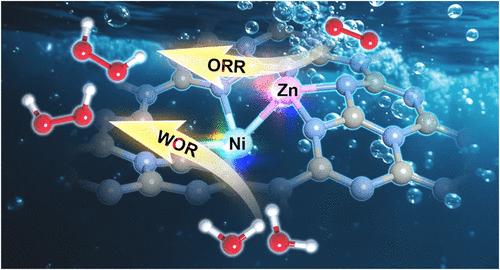Ni-Zn双原子位点实现H2O2高效光合作用的协同平行途径并具有长期稳定性
IF 15.6
1区 化学
Q1 CHEMISTRY, MULTIDISCIPLINARY
引用次数: 0
摘要
氧还原(ORR)和水氧化(WOR)途径的光催化耦合为取代高能耗的蒽醌工艺生产H2O2提供了一种可持续的策略。然而,自由基介导的催化剂降解(•O2 - /•OOH/•OH)和次优电荷动力学仍然困扰着传统的光催化系统。在此,我们将双原子Ni-Zn位点锚定在聚合物碳氮(PCN)上,制备了一种高效的光催化剂(Ni1Zn1-PCN),用于光催化H2O2的生产。有趣的是,使用氧气和水作为原料,Ni1Zn1-PCN的产率达到了创纪录的1205.4 μmol g-1 h - 1,并且具有前所未有的运行稳定性(>376 h, TON = 2659.6),优于目前报道的最佳催化剂。机理研究表明,双原子Ni-Zn位点可以诱导载体PCN的电荷转移激发,抑制电子-空穴复合。此外,双活性位点的电子相互作用/调制降低了WOR和ORR的活化能垒,从而实现了较高的整体光催化效率。这项工作标志着高效、耐用的光催化H2O2合成技术向前迈进了一步,为工业规模的可再生能源应用提供了巨大的潜力。本文章由计算机程序翻译,如有差异,请以英文原文为准。

Ni–Zn Dual-Atom Sites Enable Synergistic Parallel Pathways for Efficient Photosynthesis of H2O2 with Long-Term Stability
The photocatalytic coupling of oxygen reduction (ORR) and water oxidation (WOR) pathways presents a sustainable strategy to supplant the energy-intensive anthraquinone process for H2O2 production. However, persistent challenges in radical-mediated catalyst degradation (•O2–/•OOH/•OH) and suboptimal charge dynamics continue to plague conventional photocatalytic systems. Herein, we anchored dual-atom Ni–Zn sites onto polymeric carbon nitride (PCN) to prepare an efficient photocatalyst (Ni1Zn1-PCN) for photocatalytic H2O2 production. Interestingly, using oxygen and water as feedstocks, Ni1Zn1-PCN achieves a record yield of 1205.4 μmol g–1 h–1 with unprecedented operational stability (>376 h, TON = 2659.6), outperforming best reported catalysts. Mechanism studies revealed that the dual-atom Ni–Zn site could induce charge transfer excitation of the support PCN to suppress electron–hole recombination. In addition, the electronic interaction/modulation in the dual-active sites reduces the activation energy barriers of the WOR and the ORR, thereby achieving a high overall photocatalytic efficiency. This work marks a step forward in the development of efficient and durable photocatalytic H2O2 synthesis, offering significant potential for industrial-scale renewable energy applications.
求助全文
通过发布文献求助,成功后即可免费获取论文全文。
去求助
来源期刊
CiteScore
24.40
自引率
6.00%
发文量
2398
审稿时长
1.6 months
期刊介绍:
The flagship journal of the American Chemical Society, known as the Journal of the American Chemical Society (JACS), has been a prestigious publication since its establishment in 1879. It holds a preeminent position in the field of chemistry and related interdisciplinary sciences. JACS is committed to disseminating cutting-edge research papers, covering a wide range of topics, and encompasses approximately 19,000 pages of Articles, Communications, and Perspectives annually. With a weekly publication frequency, JACS plays a vital role in advancing the field of chemistry by providing essential research.

 求助内容:
求助内容: 应助结果提醒方式:
应助结果提醒方式:


